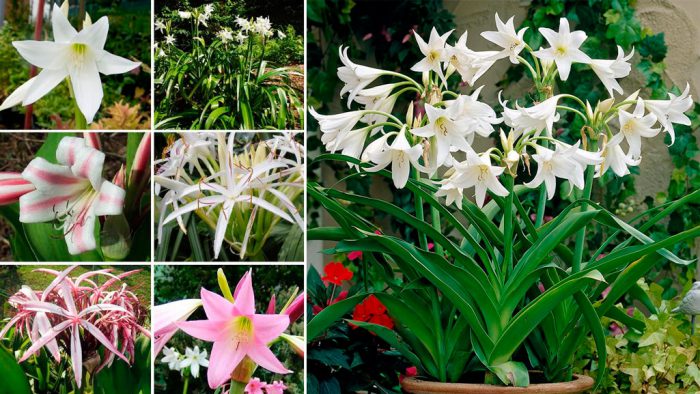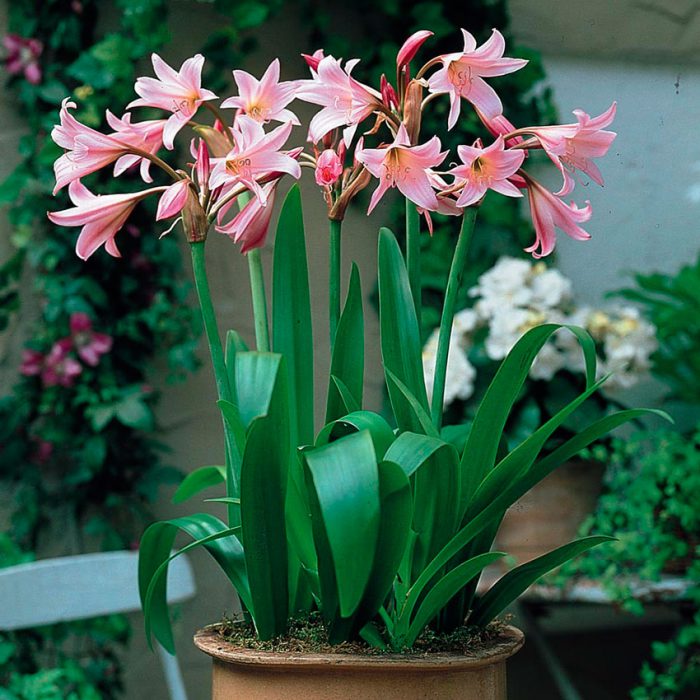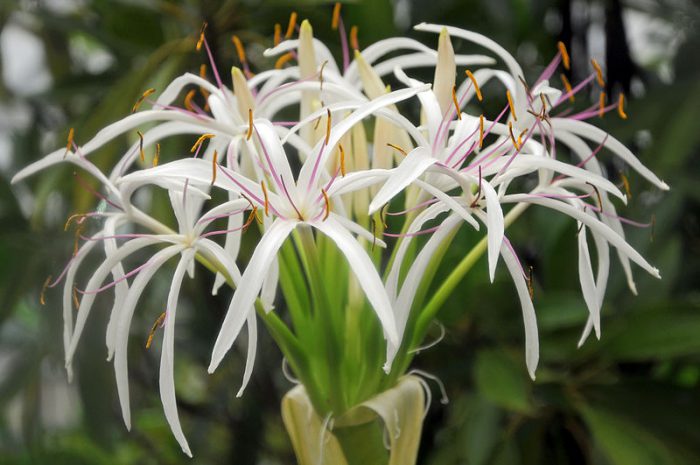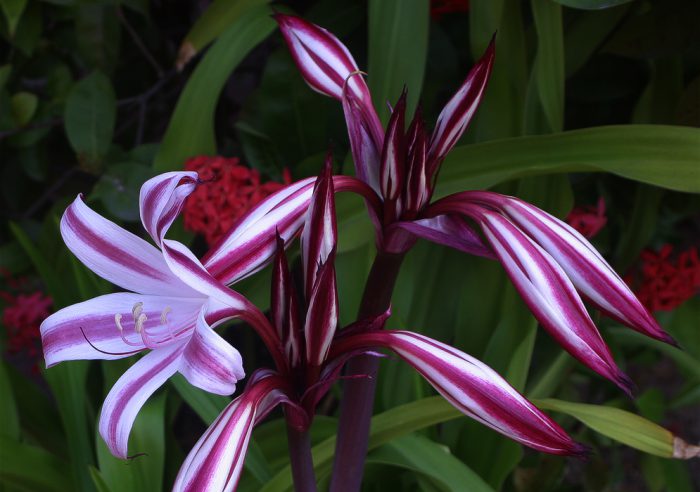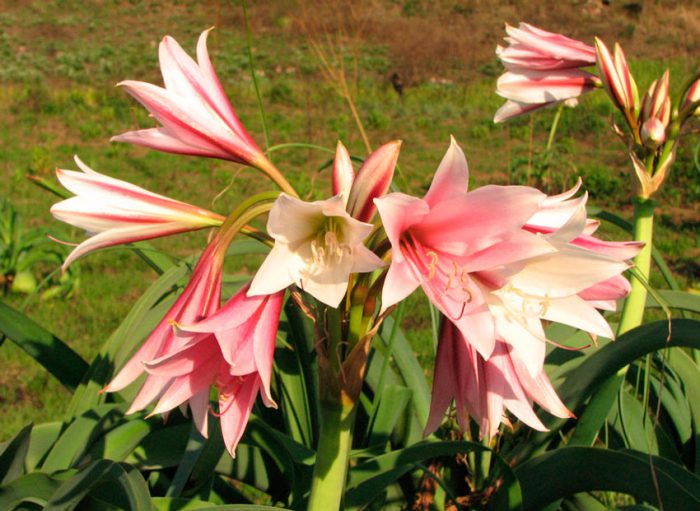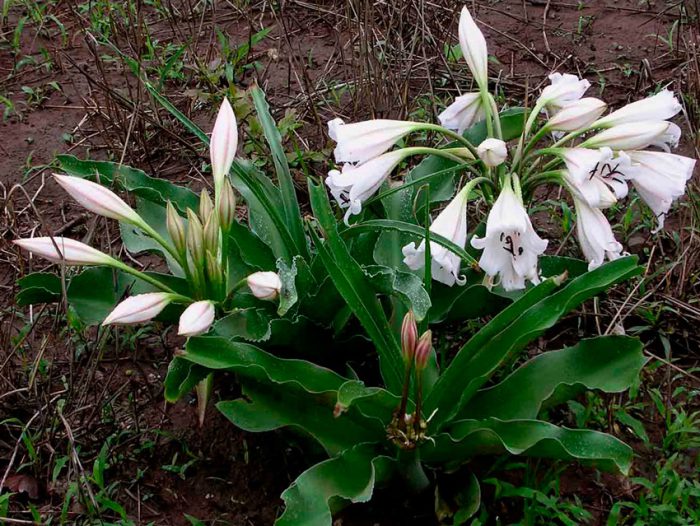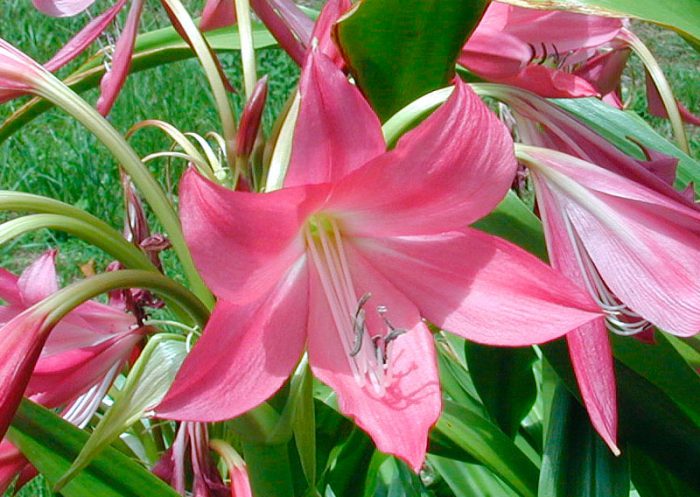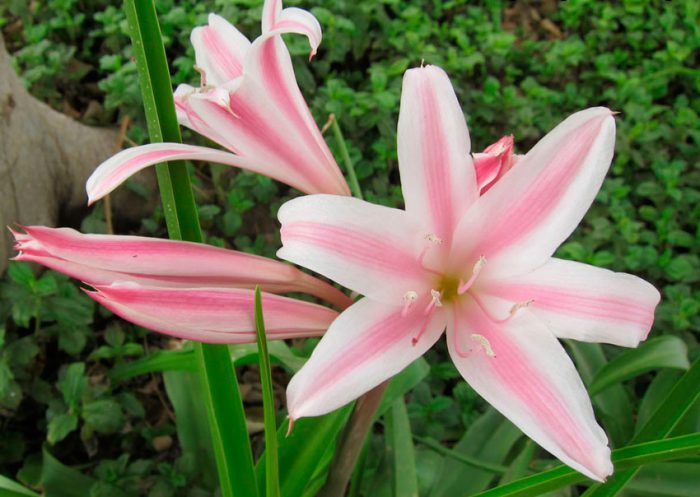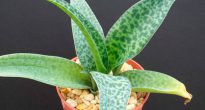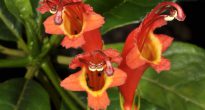A bulbous plant like crinum (Crinum) belongs to the Amaryllidaceae family. In nature, it can be found in subtropical and tropical areas. And he prefers to grow such a flower on the sea coast, on river and lake shores, as well as in those places that are periodically flooded. Several species can be found in the arid Cape Province of South Africa.
From the Latin language "crinis" is translated as "hair". The name of such a plant is associated with the appearance of the foliage. Very long, xiphoid or linear, hanging down, it really looks like hair. Having a long neck, large bulbs reach 60 to 90 centimeters in length and about 25 centimeters in diameter. The leaves are also very long and grow up to 150 centimeters. Young leaves do not have a flat shape, like most other types of amaryllis, but they are rolled into a tube. This is their hallmark. The peduncle bears an umbrella-shaped inflorescence on which large pink or white flowers flaunt. The fruit is a capsule containing large and fleshy seeds. In their shells there is a supply of liquid, which is enough for germination and the appearance of a new flower bulb, while water from the outside is not required.
Such a plant has found its use in decorating cool rooms, halls, cinemas, terraces, lobbies, and concert halls. It can also be grown in a spacious apartment, and it will also grow well in a cold winter garden. There are also species that are grown in aquariums.
Content
- 1 Crinum care at home
- 2 Main types
- 2.1 Crinum abyssinicum (Crinum abyssinicum)
- 2.2 Asian Crinum (Crinum asiaticum)
- 2.3 Big Crinum (Crinum giganteum)
- 2.4 Crinum majestic (Crinum augustum)
- 2.5 Crinum maiden, or virgin (Crinum virgineum, or virginicum)
- 2.6 Crinum campanulatum (Crinum campanulatum)
- 2.7 Crinum amabile
- 2.8 Crinum reddish (Crinum erubescens Aiton)
- 2.9 Crinum pratense
- 2.10 Crinum bulbispermum or Crinum capense
- 2.11 Crinum macowanii
- 2.12 Crinum moorei
- 2.13 Crinum Powell (Crinum x powellii)
- 2.14 Crinum pedunculatum
- 2.15 Ceylon ceylon (Crinum zeylanicum)
- 2.16 Crinum scabrum
- 2.17 Broad-leaved Crinum (Crinum latifolium)
Crinum care at home
Illumination
Needs bright lighting, no shading. Growth is faster under more intense lighting. At the end of the winter period, the flower is gradually accustomed to bright lighting, as burns may appear. It is recommended to place it on a south-facing window, while the leaves should not touch the window glass, as this can cause burns.
In summer, if possible, take the plant outside, while protecting the place from heavy rains. If grown in a room in the summer, frequent ventilation will be required. In autumn and winter, good lighting and regular ventilation are needed.With poor lighting, the leaves below them wither rapidly, but the young ones still grow. Can be grown in artificial light, with 16 hours of daylight.
Temperature regime
Such plants are divided into 2 groups:
- South African, native to the arid Cape (South Africa)... Grown in cold greenhouses. In summer, you can keep in the fresh air, while in subtropical areas they can stay outside for the winter, but light shelter will be required. In spring and summer, temperatures between 22 and 27 degrees are needed. In winter, they feel normal at 2-6 degrees.
- Originally from tropical areas. Grown in a warm greenhouse. In the summer, you can move to the street, but the place must be protected from gusts of wind. In spring and summer, it needs a temperature of 22-27 degrees. In winter, there is a dormant period. At this time, you need a coolness of 16 to 18 degrees (at least 14 degrees).
Humidity
Any humidity is suitable. For hygienic purposes, you need to regularly wipe the leaves with a damp sponge.
How to water
During active growth, watering is abundant and warm water is used. Watering is necessary as soon as the topsoil dries up. When flowering is over, you need to water less, but the soil should always be moderately moist. In winter, during the dormant period, watering should be rare, and the flower itself should be rearranged in a cool room. Do not allow the soil to dry out, as the bulbs have a rather fleshy root system, which performs its function regardless of the season.
If you want flowering to occur in winter, the dormant period must be postponed to the end of the summer and the beginning of the fall, while reducing watering. When the flower arrow begins to grow, you need to resume normal watering. To stimulate flowering, do not water the flower for 7-14 days.
Top dressing
Top dressing is carried out 2 times a month. To do this, use a liquid fertilizer for flowering indoor plants, while the dosage is used as recommended on the package. They begin to feed when young foliage appears, and stop when all the flowers wither.
Dormant period
A dormant period begins after the end of flowering. During this period, old foliage gradually withers, and new ones replace it. Krinum needs deep rest, but if it does not exist, then flowering will not come next year. In springtime, re-flowering sometimes occurs, while it is quite simple to achieve it in the Crinum Moore species.
Earth mix
To prepare the soil mixture, combine leaf and clay-sod soil, peat, humus, and sand in a ratio of 1: 2: 1: 1: 1. It is recommended to add a small amount of charcoal to the mixture.
Transplant features
The transplant is carried out before the beginning of the period of intensive growth. Adult specimens are transplanted once every 2–4 years. When planting, the bulb should rise by a third above the soil surface. You need to plant in large and deep containers, since this plant has a powerful root system. Gently remove old soil along with damaged roots. At the bottom, make a good drainage layer of expanded clay.
Reproduction methods
You can propagate it by bulbs or seeds.
You should not rush to separate the young bulbs, because thanks to them, the flowering will be more abundant. Separated babies bloom after 2–4 years (depending on their size). For planting, use a container with a diameter of 9 to 12 centimeters. After 12 months, it must be transplanted into larger pots, and after the same amount of time - in containers with a diameter of 15 to 17 centimeters. During growth, young specimens need more frequent feeding and watering. In large containers (19-24-28 centimeters), such a plant is from 3 to 4 years old, while it has a lot of baby bulbs, and abundant flowering is observed for 3-4 years.
Pests and diseases
It can settle in the leaf sinuses mealybug... Also, damage to the krinum can cause spider mite... When overflowing during the rest period, root rot appears.
Main types
Crinum abyssinicum (Crinum abyssinicum)
With a short neck, the bulb has a rounded-elongated shape, and its thickness is 7 centimeters. 6 leaves of a linear shape gradually taper towards the apex. Such leaves with a rough edge can reach from 30 to 45 centimeters in length and 1.5 centimeters in width. The length of the peduncle is 30–40 centimeters, while it bears an umbrella-shaped inflorescence with 4 to 6 flowers. White sessile flowers have short stalks. The thin tube of the perianth reaches 5 centimeters in length. The elongated petals are 2 centimeters wide and 7 centimeters long. Homeland are the mountains in Ethiopia.
Asian Crinum (Crinum asiaticum)
The bulb is 10-15 centimeters wide and its neck length can vary from 15 to 35 centimeters. There are from 20 to 30 thin, whole-edged, belt-shaped leaves, the length of which is 90–125 centimeters, and the width is from 7 to 10 centimeters. The umbrella-shaped inflorescence bears from 20 to 50 non-aromatic flowers, which are perched on three-centimeter legs. The straight perianth tube 10 centimeters long has a light green pattern on the surface. Length of linear white petals 5-10 centimeters, reddish stamens diverge in different directions. Long bloom from March to October. The homeland is the stagnant reservoirs of Western Tropical Africa.
Big Crinum (Crinum giganteum)
 With a short neck, the bulb is quite large. So, its width is 10-15 centimeters. Veins are distinctly protruding on the surface of the wavy green leaves. The length of the leaf is 60–90 centimeters, and its width is 10 centimeters. The length of a rather strong peduncle is from 50 to 100 centimeters. It bears an umbellate inflorescence, usually consisting of 4-6 flowers, but there are also 3-12 flowers. The length of the fragrant seated flowers is 20 centimeters. The curved, elongated, light green perianth tube has a length of 10 to 15 centimeters, while its pharynx is bell-shaped and 7–10 centimeters long. The width of the white petals is 3 centimeters, and the length is 5–7 centimeters, while the stamens of the same color are somewhat shorter. As a rule, flowering occurs in summer.
With a short neck, the bulb is quite large. So, its width is 10-15 centimeters. Veins are distinctly protruding on the surface of the wavy green leaves. The length of the leaf is 60–90 centimeters, and its width is 10 centimeters. The length of a rather strong peduncle is from 50 to 100 centimeters. It bears an umbellate inflorescence, usually consisting of 4-6 flowers, but there are also 3-12 flowers. The length of the fragrant seated flowers is 20 centimeters. The curved, elongated, light green perianth tube has a length of 10 to 15 centimeters, while its pharynx is bell-shaped and 7–10 centimeters long. The width of the white petals is 3 centimeters, and the length is 5–7 centimeters, while the stamens of the same color are somewhat shorter. As a rule, flowering occurs in summer.
Crinum majestic (Crinum augustum)
The width of the bulb is 15 centimeters, and the length of its neck is 35 centimeters. There are many dense belt-shaped leaves, the length of which is from 60 to 90 centimeters, and the width is from 7 to 10 centimeters. The upper part of the flattened peduncle is colored dark red. The inflorescence is in the shape of an umbrella and, as a rule, bears more than 20 pleasantly smelling flowers, which sit on short pedicels. The reddish strong perianth tube is slightly curved or straight in length reaches 7-10 centimeters. The outer surface of erect lanceolate petals has a deep red color. They are 10-15 centimeters long and 1.5 to 2 centimeters wide. Expanded stamens are colored red. Flowering occurs in spring and summer. Homeland are the rocky mountain slopes of the Seychelles and Mauritius. Grown in warm greenhouses.
Crinum maiden, or virgin (Crinum virgineum, or virginicum)
It has a large brownish bulb. Thin, belt-shaped leaflets taper both to the apex and to the base, on their surface transverse veins clearly protrude. The width of the leaves is 7-10 centimeters, and their length is from 60 to 90 centimeters. The peduncle carries an umbrella-shaped inflorescence, consisting of 6 flowers, which are sessile or have short pedicels. The length of the curved light green perianth tube is 7 to 10 centimeters. In this case, the white petals have the same length. As a rule, flowering is observed in the fall. Originally from South Brazil. Grown in warm greenhouses.
Crinum campanulatum (Crinum campanulatum)
The small bulb is oval in shape. Grooved, linear leaves with a sharp edge in length reach 90-120 centimeters.A narrow green peduncle bears an umbellate inflorescence, consisting of 4-8 flowers, located on short pedicels about 2 centimeters long. An elongated, sinuous, cylindrical perianth tube reaches a length of 4-6 centimeters, and there is also a campanulate pharynx. There are greenish stripes on its red surface. The petals are very close to each other. At the base, they are white with reddish stripes, and then the color becomes pink-green-red. Flowering is observed in the summer months. Originally from the Cape Province in South Africa, where it prefers to grow in ponds.
Crinum amabile
A not very large onion has a neck 20 to 35 centimeters long. 25–30 entire belt-shaped leaflets are 100–150 centimeters long and 7–10 centimeters wide. The umbrella-shaped inflorescence consists of 20-30 flowers, they sit on pedicels, the length of which is 2-3 centimeters. Fragrant deep red flowers have a whitish or purple hue. The length of the dark purple straight perianth tube is 8 to 10 centimeters. Linear petals have a white inner part, their length is 10-15 centimeters, and their width is 1-1.5 centimeters. The wide stamens are purple in color. Flowering is observed in winter, but most of all in March. There may be repeated flowering. It can be found in the marsh forests, as well as in the mountainous regions of Sumatra.
Crinum reddish (Crinum erubescens Aiton)
The oval-shaped bulb is up to 10 centimeters wide. Many belt-like leaflets reach 60 to 90 centimeters in length and 5 to 8 centimeters in width. The edges of the seamy side of the leaves are slightly rough. The peduncle is very long (60 to 90 centimeters). It bears 4-6 large fragrant flowers, which can be either sessile or have short pedicels. The outer part of the flower is red and the inner part is white. The erect, light-red perianth tube is 10-15 centimeters long. Petals are lanceolate, oppositely directed. Flowering is observed in the summer months. Originally from tropical America.
Crinum pratense
The egg-shaped bulb has a short neck and reaches a diameter of 10 to 15 centimeters. As a rule, there are 6-8 linear leaflets, which reach 45-65 centimeters in length. The length of the peduncle is 30 centimeters, and its width is 1.5 centimeters. Umbellate inflorescence bears from 6 to 12 white sessile or short stalks of flowers, which reach 7-10 centimeters in length. The width of the lanceolate petals is 1.5 centimeters, and their length is the same as that of the tube. The red stamens are widened. Flowering is observed in the summer months. Originally from East India.
Crinum bulbispermum or Crinum capense
The onion has the shape of a bottle, while it has a narrow and long neck. The greenish-gray, narrow-linear, grooved leaves reach 60–90 centimeters long. They are directed upwards and have a rough edge. The almost round peduncle can be over 40 centimeters long and bears 4 to 12 flowers. Large fragrant flowers are white (sometimes with a purple tint). They are located on pedicels, the length of which is from 3 to 5 centimeters. The slightly curved cylindrical tube of the perianth is 7 to 10 centimeters long and has a whitish funnel-shaped edge. The outer surface of the 3 outer petals is colored pinkish-purple (sometimes white). Their length is 7-10 centimeters. Flowering is observed in July and August. Originally from South Africa, where it prefers to grow in shady areas with sandy soil. Grow in cold greenhouses.
Crinum macowanii
A large round-shaped bulb reaches 25 centimeters in diameter, and its neck is also 25 centimeters long. The width of the leaves is 10 centimeters, and their length is from 60 to 90 centimeters. Peduncle height is 60–90 centimeters.It bears an umbrella-shaped inflorescence, consisting of 10-15 flowers. The length of the greenish curved perianth tube is 8–10 centimeters. The pink petals are 8 to 10 centimeters long. Blooms in late autumn. Homeland - rocky mountain slopes in Natal (South Africa). Grown in cold greenhouses.
Crinum moorei
A large onion has a diameter of about 20 centimeters, and its neck can be up to 45 centimeters long. Many babies can form. There are from 12 to 15 wavy, belt-shaped leaves, the length of which is 60-90 centimeters, and the width is from 6 to 10 centimeters. On their surface there are embossed veins, and their edges are pale white smooth. The length of a powerful greenish peduncle is from 45 to 60 centimeters. It bears an umbrella-shaped inflorescence, consisting of 6-10 flowers. The pink flowers have pedicels eight centimeters long. The curved perianth tube is 7 to 12 centimeters long and has a funnel-shaped pharynx. The petals are 4 centimeters wide and 7 to 12 centimeters long. The light pink stamens are not as long as the petals. A pistil protrudes above the petals. Flowering is observed in the summer. It is most popular with florists. In nature, it occurs on rocky mountain slopes in Natal (South Africa). Grown in cold greenhouses.
Crinum Powell (Crinum x powellii)
This hybrid is obtained by crossing Moore's krinum and bulbous krinum. The spherical bulb has a diameter of 15 centimeters. The length of the belt-like leaves is up to 100 centimeters. A meter-high, leafless peduncle bears an umbrella-shaped inflorescence, which consists of fragrant flowers with a diameter of 15 centimeters. The color of the perianth is deep pink.
Crinum pedunculatum
The bulb is 10 centimeters thick and its neck is 15 centimeters long. There are from 20 to 30 leaves, the length of which is 90–120 centimeters. Flowers are collected in umbrella-shaped inflorescences, 20-30 pieces each. Fragrant whitish-green flowers have pedicels 2.5-4 centimeters long. The corolla tube is longer than the petals; there are reddish dilated stamens. Flowering is observed in the summer months. Originally from Eastern Australia. Cultivated in cold greenhouses.
Ceylon ceylon (Crinum zeylanicum)
The diameter of a round bulb is from 12 to 15 centimeters, there is a short neck. There are 6–12 thin belt-like leaves that reach 7–10 centimeters in width and 60–90 centimeters long. Their edges are slightly rough. The length of the powerful reddish peduncle is 90 centimeters, it bears an umbellate inflorescence with 10–20 flowers with short pedicels. The length of the drooping green or red perianth tube varies from 7 to 15 centimeters and has a pharynx that is placed horizontally. The width of the lanceolate-elongated petals is 3 centimeters and their upper part is horizontally spread. They are dark purple in color, have a whitish edge, and have stripes on the outside. The stamens are shorter than the pistil. Blooming is observed in spring. Originally from Tropical Asia. Grow in warm greenhouses.
Crinum scabrum
The diameter of the round bulb is 10-15 centimeters, the neck is short. Dense, wavy, grooved, glossy leaves are belt-shaped and green in color. They have a sharp edge and are 60–90 centimeters long and 5 centimeters wide. The powerful peduncle bears an umbellate inflorescence with 4–8 fragrant flowers, which can be sessile or have short pedicels. The length of the bent pale green perianth tube is 8 to 15 centimeters. The throat diameter is 6–8 centimeters. The petals range in width from 2.5 to 3.5 centimeters. Their upper part is white, and in the middle there is a wide stripe of bright red color. Flowering occurs in May and June. Originally from Tropical Africa. Grown in warm greenhouses.
Broad-leaved Crinum (Crinum latifolium)
The width of the round bulb is from 15 to 20 centimeters, there is a short neck.Many thin belt-like leaves are colored green. They are 60–100 centimeters long and 7–10 centimeters wide. The umbrella-shaped inflorescence has 10–20 flowers on short pedicels. The length of the green curved perianth tube is 7–10 centimeters. The pharynx is horizontal and has the same length as the tube. The lower surface of the thirty-centimeter elongated lanceolate petals is light red. Blooms in August and September. Originally from East India. Grown in cold greenhouses.

